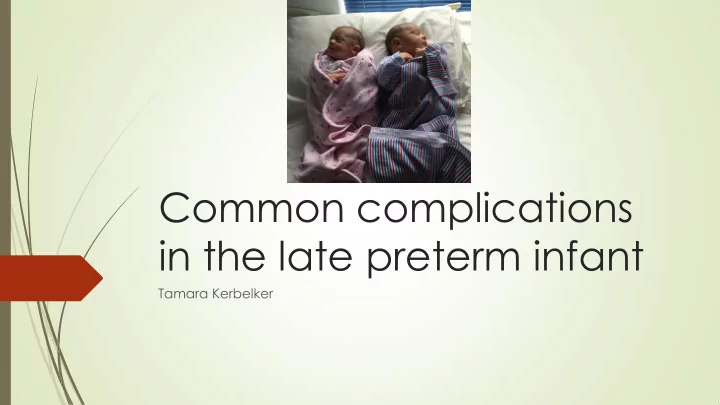

Common complications in the late preterm infant Tamara Kerbelker
Talk overview Definitions Epidemiology Short term complications Long term complications Prevention Recommendations for outpatient management
Definitions Prematurity Birth before 37 completed weeks
Classification according to gestational age Late preterm birth – GA between 34 and less than 37 weeks Very preterm (VPT) birth – GA less than 32 weeks Extremely preterm (EPT) birth – GA at or below 28 weeks
Classification according to birth weight Low birth weight (LBW) – Birth weight less than 2500 g Very low birth weight (VLBW) – Birth weight 1000-1499g Extreme low birth weight (ELBW) – birth weight <999g
Epidemiology Western Cape PPIP data 2016
Epidemiology Western Cape PPIP data 2016
Short term complications Hypothermia Respiratory distress syndrome Apnoeas of prematurity Patent ductus arteriosus Hypotension Intraventricular haemorrhage Glucose anomalies Infection Retinopathy of Prematurity
Hypothermia Rapid heat loss large body surface area inability to produce enough heat Heat is lost by conduction, convection, radiation, and evaporation Contributes to metabolic disorders - hypoglycaemia or acidosis. Increased mortality Intraventricular haemorrhage (IVH),pulmonary insufficiency, haemorrhage
Prevention of hypothermia Drying the baby thoroughly immediately after birth Removal of any wet blankets Plastic bags Kangaroo mother care (KMC) – skin-to-skin
11
Respiratory distress syndrome Surfactant deficiency Early CPAP
Apnoeas of prematurity More common in the patients with lower gestational age Stimulation Helping Babies Breathe (HBB)
Glucose anomalies Keep warm Feed early
Interventions to improve short term 15 complications and outcome Helping Babies Breathe (HBB) Management of the sick and small newborn (MSSN) CPAP to all district facilities
Long term complications 18
Long term complications Recurrent hospitalisation Increased risk of SIDS Neurodevelopmental outcomes Chronic health conditions Growth impairment Impaired lung function Effect on adult health
Recurrent hospitalisation Respiratory RSV (any viral infection) Asthma Gastrointestinal GORD Gastroenteritis
Prevention of recurrent hospitalisation Promote breastfeeding Ensure vaccinations Influenza vaccine No tobacco smoke exposure Vitamin A supplementation Limit contact with sick people Limit crowded environments (if possible) – malls, taxis RSV immunoglobulin
Growth impairment Lower weight for age Lower height for age Lower BMI Smaller head circumference
Growth impairment 23 Plot the child at every visit Head circumference Height Weight Weight for height Supplemental iron Multivitamins Vit D Wean at 6 months
Neurodevelopmental outcomes Impaired cognitive skills Motor deficits including mild fine or gross motor delay, and cerebral palsy (CP) Sensory impairment including vision and hearing losses Behavioural and psychological problems
Neurodevelopmental outcomes Infant neurological assessment (INA) Neurodevelopmental paediatrician or general paediatrician School placement ADHD management Sensory screening Vision Hearing Allied health Physiotherapy Occupational therapy Speech therapy Educational psychologist
Chronic health conditions Cerebral palsy Cognitive deficit Asthma Decreased exercise capacity Increased respiratory symptoms Chronic kidney disease Smaller kidneys Higher blood pressure Microalbuminuria
Effect on adult health Insulin resistance Hypertension Lower reproduction rate
Primary prevention Prevent the pregnancy Female empowerment Contraception Planned pregnancy Teenage pregnancy
Other prevention 29 Educate expecting moms BANC sites and the importance of antenatal care Maternal nutrition Treatment of STIs, TB HIV testing and prevention during pregnancy Alcohol and drug use during pregnancy
What can we do 30 Supplements at discharge Encourage any breastfeeding Educate moms on basic life support Educate moms about risk factors for SIDS Apnoea monitors Synagis motivation Vigilance with any ARI Encourage immunisation Follow up visits Monitor growth and development Facilitate allied health visits
31 Questions? 2017-08-08
Recommend
More recommend